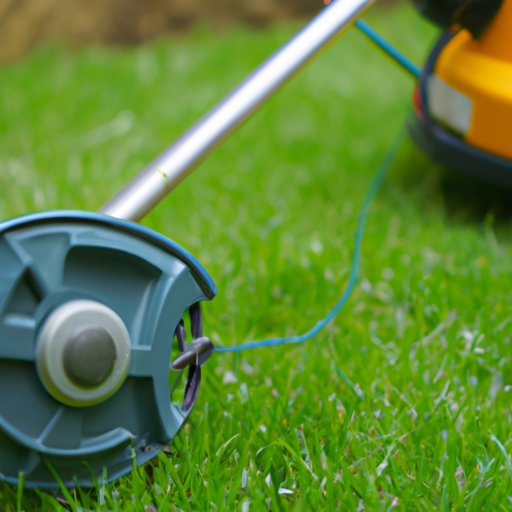Introduction
Edging is an important part of lawn maintenance, and a weed eater can be an effective tool for this job. But using a weed eater correctly requires some knowledge and experience. In this article, we’ll explore all the basics of edging with a weed eater so you can get the best results.
Definition of Edging
Edging involves trimming grass and weeds that are growing too close to borders, walkways, and other areas of your property. It creates a neat and tidy look and can also help prevent the spread of weeds. To edge properly, you need the right tools and techniques.

Overview of Weed Eaters and Edging
A weed eater, also known as a string trimmer or brush cutter, is a powerful tool used to cut grass and weeds. It has a long shaft with a motor at one end and a rotating head at the other. The rotating head contains a spool of nylon string or metal blades that spin rapidly, allowing you to trim grass and weeds quickly and easily.
Basics of Edging with a Weed Eater
How to Operate a Weed Eater for Edging
Before you start edging, read the user manual for your particular model of weed eater. This will provide important safety information and instructions on how to operate the machine. Once you’ve familiarized yourself with the machine, it’s time to start edging.
To begin, turn on the weed eater and adjust the handlebar to a comfortable position. Hold the weed eater firmly with both hands and stand with your feet slightly apart. Move the rotating head in a sweeping motion along the edge of the lawn or driveway. Make sure to keep the weed eater parallel to the ground and move slowly to avoid damaging the blades or string.
Understanding the Different Types of String
The type of string you use in your weed eater will affect the quality of your edging. Nylon strings come in different shapes, sizes, and thicknesses, so it’s important to choose the right one for the job. For most edging jobs, a thick, round string is best. Metal blades are also available for heavier-duty jobs.
Techniques for Effective Edging
Trimming Along Borders
When edging along borders, such as driveways, sidewalks, and flower beds, it’s important to move the weed eater slowly and steadily so you don’t miss any spots. You want to create a clean line between the grass and the border. Use a back-and-forth motion to ensure that you’re cutting evenly.
Working Around Curves and Contours
When edging around curves and contours, move the weed eater in a circular motion. Start at the outside of the curve and work your way inward. Be careful not to move too quickly, as this can cause the string or blade to catch on the grass and damage it.
Creating Straight Lines
For straight edges, such as along walkways or walls, use a guide line to ensure that you’re cutting in a straight line. Mark the guide line with a piece of chalk or spray paint. Then, move the weed eater slowly along the line, keeping the rotating head parallel to the ground.
Safety Precautions
It’s important to take safety precautions when operating a weed eater. The following tips will help you stay safe while edging:
Protective Gear
Wear protective gear, such as safety glasses and hearing protection, when operating a weed eater. This will help protect your eyes and ears from flying debris.
Avoiding Overheating
Don’t run the weed eater for too long without taking breaks. This can cause the motor to overheat and could lead to engine failure.
Keeping Children Away
Keep children and pets away from the area while you’re edging. The weed eater can cause serious injury if it’s used improperly.
Maintenance
Regular maintenance is essential for keeping your weed eater in good working condition. Here are some tips for maintaining your weed eater:
Replacing String and Blades
Replace the string or blades regularly to ensure that they’re sharp and in good condition. Dull blades and strings won’t cut as efficiently and can cause damage to the grass.
Cleaning the Weed Eater
Clean the weed eater after each use to remove dirt and debris. This will help keep the motor running smoothly and extend the life of the machine.
Storing the Weed Eater Properly
Store the weed eater in a dry, secure location. Covering it with a tarp or plastic sheet will help protect it from dust and moisture. Also, make sure to empty the fuel tank before storing the machine.
Conclusion
Edging with a weed eater is a great way to keep your lawn looking neat and tidy. With the right techniques and safety precautions, you can achieve professional-looking results. Remember to replace the string or blades regularly, keep the machine clean, and store it properly. With these tips, you’ll be able to edge like a pro!
Summary of Important Points
This article provided an overview of edging with a weed eater, including how to operate the machine, choosing the right string, and understanding the different techniques. Safety precautions and maintenance tips were also discussed. By following these guidelines, you can ensure that your edging projects are done safely and effectively.
Recommendations for Further Learning
If you’re interested in learning more about edging with a weed eater, there are many resources available online. The Lawn Care Academy website offers comprehensive tutorials on edging with a weed eater, as well as videos and FAQs. Additionally, Consumer Reports offers buying guides and reviews of different models of weed eaters.
(Note: Is this article not meeting your expectations? Do you have knowledge or insights to share? Unlock new opportunities and expand your reach by joining our authors team. Click Registration to join us and share your expertise with our readers.)
